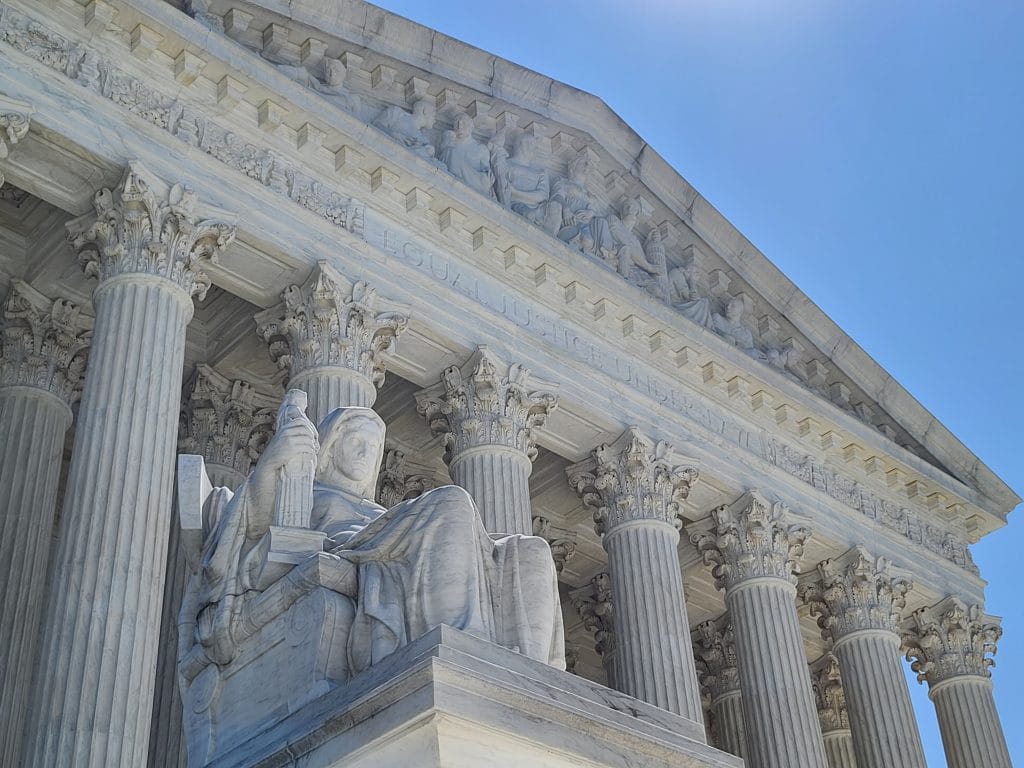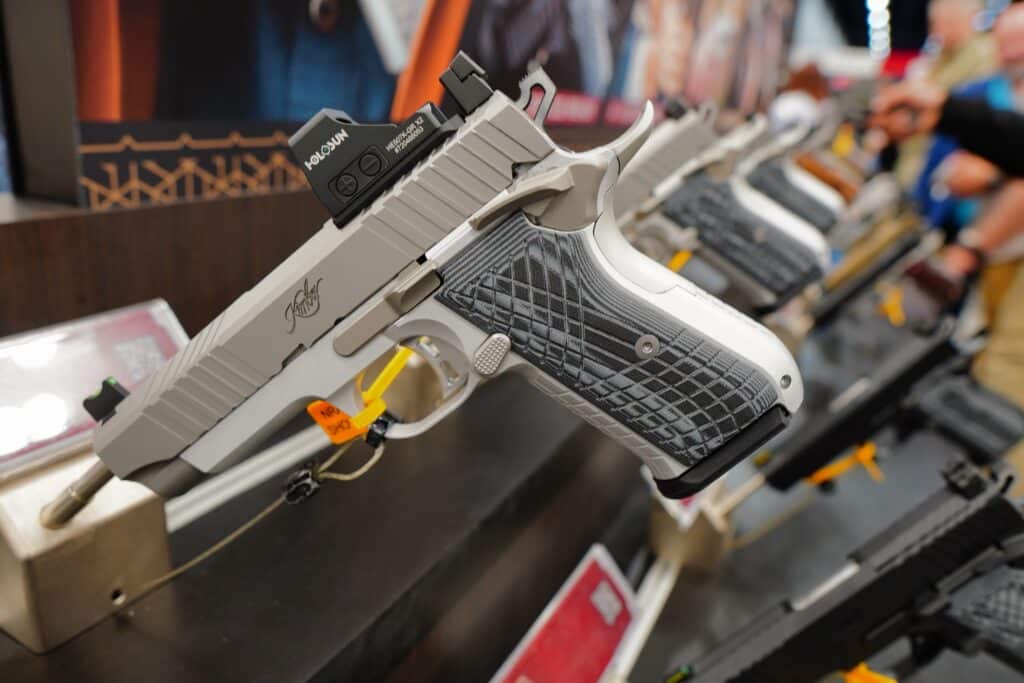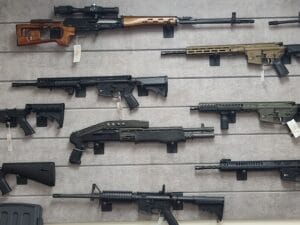On Tuesday, the Supreme Court held oral arguments in its first Second Amendment case since it handed down a landmark ruling in Bruen. The outcome of United States v. Rahimi could have sweeping effects on who can and can’t own guns. And, as Contributing Writer Jake Fogleman explains, there were certain themes in the justices’ questions that may give us insight into where they might come down.
Plus, gun scholar David Kopel joins the podcast to give his own perspective on what to make of Rahimi‘s oral arguments. And why he thinks the Court will start taking more and more Second Amendment cases.
We also have more from my exclusive interview with Israeli Knessett leader Simcha Rothman on the surge in civilian gun ownership since the October 7th attack. The details of how the country’s laws work, and how they’re changing, reveal a number of differences in how it approaches guns compared to the United States. But some interesting similarities as well.
Your chance to help out wounded veterans AND shoot guns with me is here. Just one day left to bid on my range day in Homes For Our Troops 7th Annual Celebrity Auction! I’m a certified firearms instructor, so people of all skill levels are welcome. I can also do it up on the farm in Pennsylvania or down near my home in Northern Virginia.
If that’s not your speed, there are a ton of other great offerings up for sale. All proceeds go to build specialized homes for wounded troops. Bid now!

Analysis: Reading the SCOTUS Tea Leaves in Rahimi [Member Exclusive]
By Jake Fogleman
The Supreme Court officially heard oral arguments in its latest big Second Amendment case on Tuesday. There were hints at which way they plan to come down on the future of the federal gun ban for domestic violence restraining orders.
Over the more than 90 minutes of back and forth between the nine justices and the attorneys on either side, it became clear that most of the Court was uncomfortable with the idea of Zackey Rahimi—who was found by a judge to pose a violent threat to his girlfriend and is accused of a string of other violent crimes—being allowed to possess a firearm.
“You don’t have any doubt that your client is a dangerous person, do you?” Chief Justice John Roberts asked Mr. Rahimi’s lawyer, J. Matthew Wright. After Wright questioned what the Chief Justice meant by “dangerous,” Roberts replied, “Well, it means someone who’s shooting, you know, at people. That’s a good start.”
While the rest of the arguments were more complicated and involved other legal questions than that one exchange, it nevertheless represented what turned out to be the defining theme of the day.
Even the Court’s more conservative justices, including Samuel Alito and Bruen-test author Clarence Thomas, offered little pushback on the Government’s desire to disarm specific categories of people aside from a few questions surrounding the procedural protections afforded through the common issuance of restraining orders.
The biggest question in Rahimi, then, does not appear to be whether the Supreme Court will overturn the Fifth Circuit’s ruling and uphold section 922(g)(8). Instead, the bigger question appears to be how the Court plans to do so and whether it will offer guidance on how other courts should evaluate other gun prohibitions moving forward.
A “Responsibility” Test?
As in Roberts’ question, the concept of “dangerousness” loomed large throughout the oral argument. That principle likely holds the key to how the Court plans to issue its decision.
Both the Government and Rahimi’s lawyers agree that the country’s tradition of gun regulation is missing a “historical twin” for the modern-day gun ban for those under domestic violence restraining orders. That means to uphold the law, the Court will have to analogize to some other Founding-era history and tradition of disarmament.
Solicitor General Elizabeth Prelogar argued that the Court should uphold the ban based on a tradition of allowing governments to disarm individuals who are not “law-abiding or responsible.”
“Throughout our nation’s history, legislatures have disarmed those who have committed serious criminal conduct or whose access to guns poses a danger, for example, loyalists, rebels, minors, individuals with mental illness, felons, and drug addicts,” she said.
Several of the justices, however, bristled at the notion of identifying a tradition of disarmament based on “responsibility.”
“What if someone is categorized as irresponsible for not storing firearms properly?” Justice Thomas asked.
“Responsibility is a very broad concept,” Chief Justice Roberts added. “It seems to me that the problem with responsibility is that it’s extremely broad, and what seems irresponsible to some people might seem like not a big deal to others.”
But after some further back and forth, Prelogar retreated. She said the Government was merely using “law-abiding” and “responsible” as a stand-in for someone “whose possession of firearms presents an unusual danger beyond the ordinary citizen.” This narrower understanding of responsibility as a measure of dangerousness—rather than as a subjective judgment of virtuousness—was something the justices began to coalesce around.
“I mean, I think there would be little dispute that someone who was guilty, say, or even had a restraining order — that domestic violence is dangerous, okay. So, someone who poses a risk of domestic violence is dangerous,” Justice Amy Coney Barrett said.
Even Rahimi’s lawyer conceded that history supported arms rights being removed from certain people based on a finding of dangerousness—though he disputed whether that history applied to his client and if arms rights could be curtailed in the home.
One path the Court could take is finding that Mr. Rahimi can be disarmed based on a historical tradition of disarming dangerous people without adopting the sweeping “responsibility” standard. That would address the question of whether disarming people who have been specifically determined to pose a danger in a restraining order proceeding is allowed, but it would leave questions surrounding who else is allowed to be disarmed largely unanswered.
Justice Neil Gorsuch, for his part, seemed particularly sympathetic to the idea of issuing a narrower ruling. The bulk of his exchanges with the attorneys on both sides focused primarily on the limits case at hand and why due process concerns and other specific critiques of 922(g)(8) should be left to other cases.
A “Dangerousness” Test?
A separate course of action, one much farther reaching in scope, would be for the Court to establish a broader principle of dangerousness that would instruct future courts and implicate those other disarmament cases.
“How does the government go about showing whether certain behavior qualifies as dangerous?” Justice Barrett asked. “Because this might be in a heartland, but then you can imagine more marginal cases.”
Some of those more “marginal cases” came up by name during the oral argument. Range v. Garland, a case involving a Pennsylvania man with a nearly 30-year-old conviction for lying on a food stamp application who sued to have his gun rights restored, was explicitly cited in an exchange between Justice Barrett and the Solicitor General. The Third Circuit struck down the federal prohibition on felons possessing firearms as applied to Mr. Range in June, and the Government has asked the Supreme Court to weigh in.
Solicitor General Prelogar conceded that her desire for the Court to set a disarmament standard based on “law-abiding” and “responsible” as its guiding principles was so that “dangerous” people like Mr. Rahimi would fail the responsible prong while convicted felons, whether violent or non-violent like Range, would fail the law-abiding prong.
“We think that there are additional arguments that can be made to defend felon disarmament and that those depend on the unique history and tradition with respect to criminal conduct,” she said. “And so we would hope to have the opportunity to present those arguments and perhaps persuade you in a future case.”
Justice Barrett previously articulated a historical framework for disarming certain individuals based on dangerousness alone in a dissenting opinion when she was on the Seventh Circuit Court of Appeals. If enough of the other justices also feel that “dangerousness” should be the sole determinative factor supported by history for disarming someone, the Court could issue an opinion establishing as much.
That would solve the question in this case and significantly impact the legal analysis in cases like Range and many of the other challenges to the federal gun prohibitions percolating up through the lower courts. It would undoubtedly be a far more impactful decision.
Uncertainty Remains
To be sure, it’s important to be cautious about drawing sweeping conclusions based on the tenor of oral arguments alone. While they can be illuminating, they do not always tell the whole story. In the Bruen oral arguments over New York’s gun permitting regime, for instance, Chief Justice John Roberts seemed to question the logic of allowing any permitting whatsoever for public gun carry.
“Regardless of what the right is, it would be surprising to have it depend upon a permit system,” he said. “You can say that the right is limited in a particular way, just as First Amendment rights are limited, but the idea that you need a license to exercise the right, I think, is unusual in the context of the Bill of Rights.”
Taken on their own, these comments seem to suggest the Chief Justice was open to making permitless carry the law of the land. But when the Bruen decision was handed down, Roberts joined a concurrence from Justice Brett Kavanaugh, strongly emphasizing that the Court’s decision was not to be understood as casting legal doubt on permitting regimes that are objective and neutrally applied to all applicants.
But the overall tenor of the oral arguments in Rahimi left an unmistakable impression. Many legal experts agreed, long before the Court ever heard the case, that preservation of the federal domestic violence gun ban was the to be the likely outcome. The fact that most of the justices devoted precious little time to probing any potential infirmities in the federal statute during questioning and mainly focused on the proper standard for upholding it only lends credence to those predictions.
It would be a shock if the Justices were to affirm the Fifth Circuit after Tuesday’s oral arguments. What’s less clear is how much of an appetite the Court has at this point for expounding on the test it set last year in Bruen.
Podcast: Gun Scholar David Kopel Explains SCOTUS Oral Arguments in Second Amendment Case [Member Early Access]
By Stephen Gutowski
The Supreme Court just finished oral arguments in its latest Second Amendment case. So, this week on the show, we’ve got scholar David Kopel with us to give his perspective on the arguments made and the questions asked by the Justices in United States v. Rahimi.
Kopel was on the show about a month ago describing his brief in the case. And the issue in that brief came up in oral arguments. Kopel reacts to the discussion around the more problematic section of the federal law that bars those subject to domestic violence restraining orders from owning guns.
He also gave his view on the government retreating from the idea that anyone who isn’t “law-abiding” or “responsible” can be disarmed. Kopel said that retreat was significant and could have implications for other Second Amendment cases coming down the line. At the same time, he said Rahimi’s lawyer had to make his own retreats and the Justices seemed unsympathetic to his overarching argument.
Kopel predicted the Court would probably release its ruling before the summer and he expected it would uphold the ban. But he said the details of the ruling are harder to predict.
Plus, Contributing Writer Jake Fogleman and I discuss the massive upswing in Israeli civilian gun ownership after the October 7th attacks.
You can listen to the show on your favorite podcasting app or by clicking here. Video of the episode is also available on our YouTube channel. Reload Members get access to the show on Sunday, as always. The episode goes public on Monday.

Knesset Leader Explains Differences Between Israeli, American Gun Culture [Member Exclusive]
By Stephen Gutowski
Israelis are currently arming themselves for reasons and at a level likely recognizable to most Americans, but the Middle Eastern nation’s approach to civilian gun ownership draws a stark contrast to our own.
Simcha Rothman, Chair of the Israeli Knesset’s Constitution, Law, and Justice Committee, revealed this week that 150,000 Israelis have applied for handgun permits since Hamas’s October 7th attack on the country. But his exclusive interview with The Reload also revealed a number of differences–and some similarities–between how guns are viewed in Israel and the United States.
Many differences can be found in how each country regulates firearm ownership. And those stem from competing philosophical starting points. Unlike the United States, gun ownership is not considered a right in Israel, and there is no written guarantee to keep and bear arms in the country’s founding documents.
“So, it’s not an issue of a human right,” Rothman told The Reload. “But I know the discourse in the US, how do you read the Second Amendment? Is the reason for the right the need for a militia or the other way around? I’m not getting into this discussion in the US, but we know about it.”
Instead, the ability to own a gun is predicated on meeting a series of government conditions. Up until October 7th, Rothman said the most common way to qualify for a handgun permit was to live in a part of the country the government views as especially dangerous.
“The main cause, until now, in numbers was living in an eligible community or a place or working there or learning there, studying there,” he said. “So, if you’re a resident of a municipality or a community, community or a town that because of its location is eligible. Some rural places or places in Judea and Samaria, where there are more threats on the roads. Some places like this, then you’re eligible. You still need to meet some other standards.”
Rothman said that meant a background check and an age limit.
“It’s the basic standard, you need to show that the government agency checks before giving you the license,” he said. “It checks your criminal background and your health background. If you don’t have a mental illness, or some other illicit prevents you from holding a gun.”
That’s similar to the process for buying a gun in the United States. However, the Israeli process is more difficult to pass, and the age to buy handguns is set at 27 instead of 21. Additionally, once you are approved to buy a gun, you can only own one. And it must be registered with the government for your exclusive use.
“If you have a permit for a gun then you can buy it, and it’s also a specific match. It’s a numbered gun that is connected to you,” Rothman said. “You cannot have any gun. It’s registered and one per person. You cannot have dual ownership, and you cannot have one person holding two. It’s one per one.”
And that gun can only be a pistol.
“It’s all handgun. Usually, you cannot have a personal private license for a rifle,” Rothman said. “There are some exceptions. There are a few who are using special guns. If you have a hunting permit, or if you have Olympic firearms, but it’s very rare. That’s not worth mentioning. So, you get the license for your rifle for the hunting. Then you also get the handgun. So, you’ll have two or three, but that’s basically it. The handgun that you get for your own protection, this is one per person.”
Limiting civilians to one handgun for protection stands in stark contrast to how many Jewish Americans have responded to the October 7th attacks. While they too have turned to firearms for protection as some protests in America and around the world have turned from support for Palestinians to support for Hamas and their slaughter, American Jews have focused on more capable firearms. The AR-15 has become a popular option for those looking to protect themselves from similar attacks in the United States.
“I had three or four calls today that were, ‘Hey, which AR-15 should I buy?” Rabbi Yossi Eilfort, president of the Jewish security non-profit Magen Am, told The Reload last month.
Ross, who works at a software company in the Chicago suburbs and asked not to be identified over security concerns, summed up the American view of what kind of arms it would take to effectively prevent a terror attack.
“I think what we saw in Israel is that if you have a group of people that are determined to come into your home and commit harm, first of all, if you don’t have a gun, good luck,” he said. “And, even if you have like a little pistol, sorry to say, that’s not gonna cut it. I’m planning on purchasing more firearms at this point.”
Rothman said about a million Israelis qualify for handgun permits under the dangerous-regions policy. However, he also noted that a majority don’t take advantage of that eligibility. He said men were far more likely to get a pistol permit than women–another similarity with the United States.
“Of course, most of them do not apply. It’s not very common, for example, in Israel, for women to apply. It’s not that they are not eligible. They’re eligible. I know myself and in spite of where I live, a lot of women carry guns, but it’s not very common,” Rothman said. “So, out of the million, of course, half of them are women, and most of them will not apply.”
He also pointed out another difference between US and Israeli gun culture. While gun ownership and military service is strongly linked in America, it is even more so in Israel. That’s because military service is required for most people in Israel. And that means more civilians understand how to handle a firearm than the number of people eligible for private gun ownership might suggest.
“Keep in mind that in Israel, unlike the US, many, many people are serving in the army because it’s mandatory,” Rothman said. “And, also, many people serve in the reserve units. So, they do go to basic training and know how to use weapons. So, in a time of need. like now, we can have a strong reserve force in a short period of time. So, it’s not like an unarmed population that don’t know anything about guns.”
The nation’s leaders are hoping to capitalize on that firearms experience in the wake of October 7th as it faces down ongoing terrorist attacks and an all-out ground war with Hamas. In addition to calling up reserves from all over the world, Israel has expanded lifetime handgun permit eligibility to more combat veterans than ever before.
“It used to be if you were a combatant, to a certain degree in the infantry, you would be able to get even if you live in other places,” Rothman said. “Now, it was added that if you were a combatant it doesn’t matter where you were a combatant. Not only in the high-level infantry. Every past combatant now in Israel is eligible. This has now became, I think, the largest group. But that’s new. That was just added now.”
Despite the many differences in regulatory approach, there are many similarities in how Israelis and Americans view the utility of those civilians who are armed. Rothman said the government has also been increasingly friendly toward law-abiding civilians arming themselves. And he said armed civilians have been instrumental in preventing or stopping previous attacks.
“In the past, law-abiding citizens with handguns stopped and prevented many terrorist attacks in Israel,” he said. “There are many, many terrorists that were killed on the site by law-abiding citizens carrying a gun. They didn’t wait for the law enforcement. That saved many, many people. So, every spike in terror was always bringing motivation.”
Additionally, American and Israeli views on gun carry match up in a number of ways. Most American states, though not all, have moved to a permitless carry system that’s similar to the one in Israel. If you can own a pistol, you can carry it.
“We don’t have special permits for this and that,” Rothman said. “In Israel, there is no different concealed carry. It’s not a thing.”
In fact, he said Israelis are generally expected to carry a handgun if they are given a permit to own one. He noted open carry is also allowed, as it is in most American states. Only brandishing with the intent to threaten people is illegal.
“You can walk around, and people will see that you have a gun,” Rothman said. “You can’t show your gun in a threatening way, but you can walk with it.”
But, as in America, most gun owners prefer to carry concealed for tactical reasons.
“You don’t have to conceal it, but most people will have it under their shirt or something like that because they don’t want everyone to see that they have a gun or to be an easy target for someone to try to take it away from you or to attack you,” he said. “So, most people carry it on their person, but it’s concealed.”
So, the differences between American and Israeli gun cultures are stark. But similarities also exist and, likely, many more than in most other countries that all but completely ban civilian gun ownership. It will be worth watching to see which direction Israel’s gun culture evolves from here. Will it move more toward the American exception or the global norm?
That’s it for now.
I’ll talk to you all again soon.
Thanks,
Stephen Gutowski
Founder
The Reload






